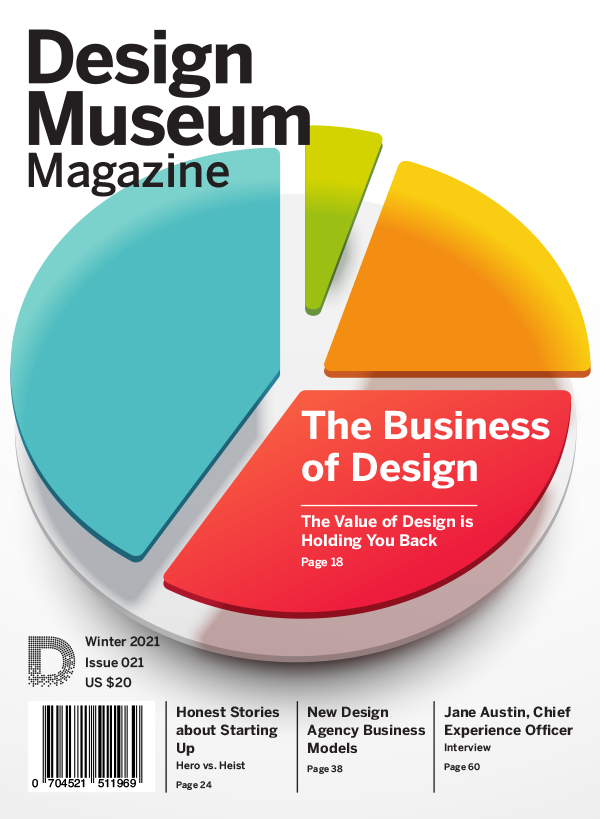The Design/Business Dependency
Can education bridge the gap?

By Adrian Gill, Founder, Ad Hoc Industries
Business and design don’t fully understand each other. The state of the relationship between designers and the businesses they work with is a symptom of two fundamental problems: business leaders not understanding just how much value designers can bring to the table, and designers not having the type of business education they need to hone their natural entrepreneurial mindset further.
Designers have much in common with entrepreneurs. They frequently start from a blank sheet of paper, and are constantly developing and pitching new ideas. They are visual storytellers, drawing on their future forward view of the world to generate new ideas to creatively solve problems in innovative ways. Conversations with designers are about creating something that does not yet exist.
Some of the world’s most successful companies — from Tesla and Apple, to architecture firm Bjarke Ingels Group — have seamlessly integrated business and design, offering examples of how the two fields can coexist in viable, impactful ways. Designers have seats at the leadership tables of these organizations, and they all seem to have avoided the suspicions with which business and design often view each other.
The design outcome is the most telling part of a great relationship between business and design. Instances where we see forward thinking, well-differentiated products that resonate with consumers is the proof of the business-design relationship working well. For example, Bjarke Ingels Group’s early award-winning Copenhagen housing project was one of the projects that jump-started their business success. The Mountain Dwellings marked a reimagination of multi-level underground parking — 80 single-level apartments, in a 10 story building, all have private parking with roof gardens facing the sun, glass facades, and wooden terraces. The design creates a suburban neighborhood with sunlight, fresh air, and gorgeous views in an urban environment. This successful end result is telling of how well Bjarke Ingels Group’s business and design teams work together.
Tesla’s Cybertruck design received 200,000 pre-orders within a month of launch, and is now influencing electric truck design from other brands. The Tesla model 3 is the best selling vehicle in Europe right now — not just the best selling electric vehicle, but the best selling vehicle. This product is a success because of the trust cultivated between business leaders and design leadership at Tesla.
The Apple story is well-traveled but continues to be a compelling example of the innovation possible when design and business work together. Apple challenged why our computers should merely be beige or gray. Then the iPhone put our lives in our pockets. The Apple Watch design changed the nature of our relationship with wristwatches. Everyone knows about Apple’s unrelenting attention to design.
These examples all require and represent one thing: design leadership, and the freedom to innovate that comes when there’s trust in the relationship between business and design leaders. The leaders of Apple, Tesla, and Bjarke Ingels Group recognize the power of design as an integral part of their strategy to unlock opportunities within their industries — and they succeed many times over.
Yet, despite these successes, many business leaders see design and designers as afterthoughts. Too many of the startup CEOs I’ve advised think that design is simply a task that can be outsourced. Even when companies get larger and have bigger budgets, organizational charts list the design department as simply a part of marketing. For too many business leaders, design is a discretionary spend or a department of people who follow production instructions from the C-suite. Designers rarely have a seat at the leadership table.
The state of the relationship between designers and the businesses they work with is a symptom of two fundamental problems: business leaders not understanding just how much value designers can bring to the table, and designers not having the type of business education they need to further hone their natural entrepreneurial mindset. So what if we could teach business to designers in more creative ways? What new forms of collaboration and products could come out of this? How much more could designers offer to the business world?

Mountain Dwellings apartment building by architecture firm Bjarke Ingels Group

Tesla Cybertruck

Apple iPhone & Watch
What Designers Bring to the Business Table
Designers have even more to offer to business than their aesthetic sense and creativity. In fact, perhaps their greatest trait is their curiosity. Designers constantly take on feedback, pivot, and adapt, allowing them to synthesize many different opinions and resolve conflicting directions. Throughout the design process, many iterations do not work, and some fail altogether. Designers are comfortable with failure and compromise. They collaborate profusely, and often get to BATNA — the best alternative to a negotiated agreement quicker than others. Designers also inherently understand consumer behavior and aversion to the predictable and clichéd, as designers’ sense of curiosity drives design direction. What makes a designer successful in the business world? Among other things, a willingness to continue to be curious about many different paths, evaluate and try new options. They persist until they reach a design direction that meets the brief and shared goals.
Business leaders, while often understanding that great design is important, believe that designers are just “too expensive” for their company. Instead, they explain they would rather start with something basic and improve the design later on. For many business leaders, investment in branding comes only after the company brings in tens of millions of dollars of revenue. This line of thinking is not only misguided, it’s more expensive. In a business environment where every move is immediately visible, filled with large, well-funded agile competitors, great design is one of the few ways to truly differentiate your brand.
Think of it this way: it’s better to invest in fantastic creative for your ad campaign, and spend less money on ad distribution, than having poor advertisements and distributing them widely. For the young CEOs I advise, I encourage them to look at how much of their marketing budget is allocated towards social media and digital advertising and consider whether these ads would perform better if the ads themselves were higher-quality. If the answer is yes, it might be worth spending more on designers. Better yet, designing great products and services in the first place would make marketing them easier from the outset.
A Business Mindset for Designers
Most designers would rather spend their time doing what they love — pursuing new ideas to design beautiful things. We should protect and encourage this mindset. Maybe it’s more about adopting “business mindfulness” as designers versus turning designers into business people. I believe designers can actively create a world where more companies put design at the forefront of their organizations. Designers can create more visual and accessible language, systems, and processes to make business more understandable and intuitive.
In a recent conversation with Jutta Friedrichs, Co-founder and Design Chief at Soofa, she mentioned that she particularly enjoyed her accounting and finance courses. This surprised me, but she explained that for once, there was a concrete answer. One plus one always equals two. Her point? Everything else in her world was subjective, and so it came as a relief to have more definitive answers. These kinds of courses are worth teaching to designers, but they could be even more impactful with intentional and visual demonstration to the design community.
Designers also need to hear stories from advisors and peers in their industry about how a business education has impacted their careers. For instance, I’m a former accountant at PricewaterhouseCoopers and graduate of Harvard Business School. Through my experience at Puma, where I led the Footwear Division, I had a close up view of both worlds that typically have two different mindsets. Now, as founder of a creative agency and Brand Experience and Creative Director at the Harvard Innovation Labs, 90% of my time is spent on creative work. As much as I willed my career away from a traditional business path, I’ve come to see my education in the field as a tremendous asset.
At Puma, I would conduct design reviews for new footwear collections, and at the same time, be responsible for financial projections of that collection for price negotiation with factories, which would influence decisions on whether to open new tooling for styles or use existing tooling. This role required the ability to lead design talent, understand design direction and intent, and to explain how a design was differentiated from the competition and its desirability to consumers. This balance of design and business was more comfortable because of my business background. In business related discussions, I had a certain credibility and confidence from my understanding of the business implications of design choices. In turn, in conversations with designers, it was easier for me to discuss tough decisions and work with them to find creative solutions to potential roadblocks. Typically the creative and the business mind are manifested in two different people in any organization. It’s a distinct advantage to have both skills in one person.
Rethinking Business Education for Designers
If we want to create a world where more companies put design at the forefront of their organizations, designers will have to will this vision into reality. We must collectively design new, more effective systems to help fellow designers pursue and actively embrace business education.
Should teaching business and entrepreneurship to designers be done primarily through the lens of other creative industries? Perhaps we can learn from the film industry. Filmmaking in many respects is directly related to venture creation. General steps in filmmaking roughly follow the same path as building a venture: Start with a question, research, and development of a idea/storyline, write the script, develop a storyboard, create a plan and budget, curate a team of collaborators (cast and crew), pitch potential investors (executive producer(s)), film the project, pitch to film festivals, promote the project, and negotiate distribution deals. The creation of independent films is the closest to the venture creation experience. Perhaps design schools should convene filmmakers and designers and use the filmmaking process as a vehicle to teach business and entrepreneurship.
Encouraging more designers to pursue business education requires changing how we teach business to designers. What would an income statement in an accounting class look like if a designer were teaching it: visually, would it look the same? Should we reimagine business concepts to cater to more visual-minded individuals? What if a balance sheet was visually balanced? What does the equation Assets = Liabilities + Owners Equity become with a more imaginative execution? If we found intuitive ways to unlock the mystique of financial statements, and business concepts became more accessible to designers, might this then translate to a better connection with consumers? In turn, might this amplify and scale design leadership in business? This is an area that is ripe for disruptive thinking.
As I mentor creatives in the SCADPRO program at the Savannah College of Art and Design, which aims to develop creative business leaders, I hear confidence in brand building but sense hesitation around numbers. Here, I can advise that they have 80% of what it takes to build a business; well-defined brand positioning and differentiation, which requires strong design and creative thinking. The 20% gap, or the business part, is easier to close. It is easier to teach designers business than it is to teach business people design. There is much more certainty and predictability in business that enables decision-making. This makes it easier to teach business to anyone, including designers. Teaching design to business professionals is more difficult as it requires cultivating the creative instinct and aesthetic choice, which are harder skills to teach because they are so subjective. The point is not that one designation is better, but more importantly that they need each other.
What’s going to be prized in the future is creative multi-dimensional thinking over one dimensional thinking. It’s a real loss not to bring business thinking to the creative arts and design to business schools. What if design itself, and not just design thinking, was mandatory for business students? Design should become a meta-discipline akin to writing and persuasion. With a new appreciation for the value of creative credentials, can business schools foster more creative thinkers? Business students may find starting or growing a venture is more straightforward when you have the tools to communicate your ideas, frameworks for creative problem solving, and strategies for effective branding.
Future business success will increasingly be due to people who realize this design/ business dependency and actively look to create environments and curricula that feed good ideas into a new educational ecosystem. Cultures where design and business leadership are not just working closely together, but seamlessly intertwined, and equally rewarded, will succeed. That’s a design future I dream to be a part of.
